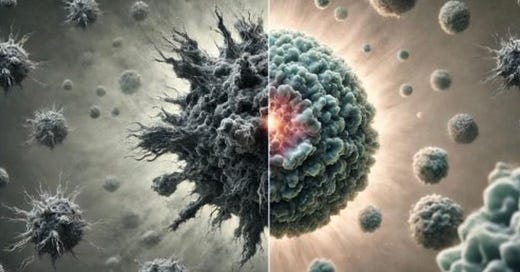This week we examine a new method for flipping cancer cells back into their original healthy state. We investigate a couple of advances in refrigeration that may change how we keep things cool. Finally we look at a new supercapacitor that can self charge. When combined with a solar cell it can store and use electricity in real time.
Flipping Cancer Cells
A team at the Korean Advanced Institute of Science and Technology have figured out how to manipulate a few genetic switches and cause colon cancer cells to revert back to a healthy state.
The team used a digital model of the gene network of normal cell development. They found that there were several molecules that they termed ‘master regulators’. These molecules were involved in the differentiation process of the cells lining the intestinal walls. The regulators, MYB, HDAC2 and FOXA2 were suppressed and the cancer cells switched back to a normal like state removing the cancer. The tests were initially carried out digitally before being replicated in mice.
The team was also able use their digital model to discover four master regulators in the hippocampus region of mouse brains. Two of them are responsible for over expression in the cellular differentiation process and one was responsible for inhibition. This might give a clue to how to approach the reversal of brain cancer. The digital modeling tool may also become a way to fight other cancers in the body.
Advances in Refrigeration
Plastic Crystals in place of Gases
A team from Deakin University, University of Sydney and Monash University have found a type of plastic crystal that can be used as a refrigerant. The plastic crystal might be able to replace the greenhouse gases currently used in most refrigerators.
Most modern refrigerators use R-134a, a hydrofluorocarbon rather than Freon. Freon was a significant contributor the breakdown in the Earth’s ozone layer and was phased out over the past 25 years. R-134a is a greenhouse gas that causes problems when it leaks from refrigerators.
The team tested a range of plastic crystals to find one that can viably chill the air when it is compressed at ambient temperatures. Several were found to be capable of removing heat from the air at temperatures ranging from -37C to 10C.
A compression chamber was used to squeeze the crystals and a fan blew the cooled air into the area surrounding the device. By repeatedly squeezing and un-squeezing the crystals they formed a clean refrigerant. Future work will concentrate on the amount of pressure required to squeeze the crystals as it is currently an expensive way to cool a home.
Thermogalvanic Refrigerators
A team from Huazhong University of Science and Technology in Wuhan have a new form of refrigeration based upon thermogalvanic cells. This new type of refrigeration uses far less energy and it is scaleable.
Thermogalvanic cells use the heat produced by reversible electrochemical reactions to create electrical power. Reversing this process by applying an external electrical current enables cooling. Previous studies have shown that thermogalvanic cells have a limited potential to produce cooling however the team was able to dramatically increase the potential by optimizing the chemicals used.
Cooling thermogalvanic cells use dissolved iron ions. Fe3+ is converted to Fe2+. This cools the surrounding solvent. When the reaction is reversed a heat sink will remove the unwanted heat. By tweaking the solvent the team improved the cell’s cooling power. They used a hydrated iron salt containing perchlorate to allow the iron ions to dissolve and dissociate more freely. This improved the cooling power by 70%.
The team is now working on commercial applications which could range from wearable cooling devices to industrial grade equipment. They also hope to improve performance by exploring new mechanisms and other advanced materials.
Self Charging Supercapacitors
A team of researchers from several Korean Universities have developed a high performance self charging energy storage device capable of efficiently storing solar energy.
The team designed new electrodes using a nickel based carbonate and hydroxide composite materials. They added Magnesium, Cobalt, Copper, Iron and Zinc to improve the conductivity and stability of the electrodes. This gave the supercapacitor greatly improved performance in energy density, power density and charge and discharge stability.
The team also combined silicon solar cells with the super capacitors to create a system capable of storing and using solar energy in real time. The energy storage efficiency of 63% makes it commercially viable. Future work will try to enhance the efficiency to improve the commercial viability.
Paying it Forward
If you have a start-up or know of a start-up that has a product ready for market please let me know. I would be happy to have a look and feature the startup in this newsletter. Also if any startups need introductions please get in touch and I will help where I can.
If you have any questions or comments please comment below.
I would also appreciate it if you could forward this newsletter to anyone that you think might be interested or provide a recommendation on Substack.







Mr Freeze is coming- need some wearable freezers.